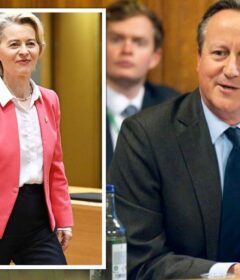The Gillibrand Test Case for Women in Politics
We just need more women.
Through Hillary Clinton and Sarah Palin, Carly Fiorina and Michele Bachmann, that’s the argument that strategists, political scientists and pollsters focusing on female candidates make about the race for the White House.
More women means less attention on pantsuits and more on political strategy. More women means a candidate is judged on her merits, not as a human proxy for more than 50 percent of the population. More women makes it easier for every woman running.
In the 2020 presidential primary, six women mounted campaigns and the field finally had more than enough women to assemble a basketball team — or to minimize the use of sports metaphors in politics, if they so chose. But the first to drop out? Senator Kirsten Gillibrand, who attempted to distinguish her candidacy by offering the most outspokenly feminist message of the field.
Of course, there are many explanations for why Ms. Gillibrand’s candidacy failed to catch fire. Like the majority of the primary contenders, she struggled to overcome campaign cash woes and strategic miscalculations, and with breaking from the pack.
But her fiercely feminist message, according to those who study women in politics, offered a powerful test case of the different ways women can run for president, and of the obstacles they continue to face — even in a field crowded with female contenders.
More female candidates in a race can help voters see women as viable political leaders without making any one campaign a referendum on gender equity. A bigger field also means that an explicitly feminist case may struggle to break through, because other choices abound.
“We know that women do believe women candidates represent them better than men and the amazing thing about this cycle is how many choices there are,” said Lauren Leader, head of women’s civic group All In Together, and who has known Ms. Gillibrand for nearly a decade. “But that meant it was harder for Kirsten. She doesn’t automatically stand out as the feminist icon in this race when there are so many other women.”
While Mrs. Clinton negotiated how best to talk about gender for much of her time in public life, all of the major female candidates in 2020 have embraced, to varying degrees, putting their experience as a woman in politics at the center of their appeal to voters. When Senator Elizabeth Warren released a proposal for universal child care in February, she discussed the policy in the context of her own personal history. “I remember how hard it was to find affordable and high-quality child care when I was a working mom with two little ones,” she wrote in a Medium post.
In May, Senator Kamala Harris announced an initiative to close the gender pay gap, grabbing headlines on a signature issue of Ms. Gillibrand’s. On the campaign trail, she describes being asked about “women’s issues:” “I’d look at them and say I’m so glad you want to talk about the economy,” she said, at a campaign event in South Carolina earlier this summer. “Women’s issues are everyone’s issues and all issues are women’s issues.”
And Senator Amy Klobuchar of Minnesota talks openly about the double-bind of being a woman in politics. “You also have to show you can do tough jobs and then people say you’re too tough. Like you can’t win, right? But you, again, have to just deal with that,” she said, in a May interview with Pod Save America.
Ms. Gillibrand distinguished herself by running on what she called a “women plus” campaign platform. She announced her candidacy with a focus on her family, saying that as a mother of young children she would fight just as hard for other people’s kids, too. Her campaign logo was Barbie pink, and her slogan — “brave wins” — a reference to a children’s book she wrote profiling famous suffragists.
In May, Ms. Gillibrand went to Atlanta for an event on abortion rights, telling a reporter that she was going “to lead the fight against these unbelievable, draconian inhumane abortion bans.” During the Democratic primary debates, she proactively brought up topics relating to issues like gender dynamics and reproductive rights, more than nearly all the other candidates, according to an analysis by the Women and Politics Institute at American University and the Barbara Lee Family Foundation, which studies and supports women in politics.
Those moments and others like them, when she leaned the most into her feminist credentials, were the times when her campaign got the most traction, say strategists and those who study women and political power.
“The question is, how do you break through in this environment?” said the Democratic operative Christina Reynolds, vice president of communications at Emily’s List. “What Kirsten Gillibrand showed is speaking directly to women’s issues and women’s voters might get you a little breakthrough.”
Tresa Undem, a pollster who specializes in surveys on gender issues, said that discussions of fairness and power carry more political currency than they used to just a few years ago. Voters have started using terms like misogyny and patriarchy in focus groups — words Ms. Undem never heard mentioned until Donald Trump won the White House.
Even so, she notes, Ms. Gillibrand’s message was not enough to distinguish her beyond the audience of the activists, strategists and political junkies covering every twist of the primary race.
“We all see her as the woman candidate but she’s not really because they’re all talking about these issues,” Ms. Undem said. “Just take abortion; every single candidate is against the Hyde amendment.”
Some of the explanation for how her campaign unfolded clearly rests with Ms. Gillibrand, who struggled to connect with a broad enough range of voters. Her efforts in the second debate to seize the spotlight by challenging former Vice President Joseph R. Biden Jr. over his position on a child care tax credit in 1981 failed to gain as much traction as earlier attacks on his record by Ms. Harris did.
“Gillibrand really pushed the Brave Wins message which was a little bit hard to get your head around. People didn’t totally understand what that meant,” Ms. Leader said.
While the other women in the race, like Ms. Klobuchar and Ms. Warren, overcame early attacks on their character, some suggest Ms. Gillibrand struggled to push back against charges that she is too politically calculating — a reputation that tends to be deployed more negatively toward female politicians than their male colleagues.
“She’s always been politically astute,” said Kelly Dittmar, a Rutgers University professor who studies female candidates. “One of the criticisms that I think is in fact imbued with sexism is that she’s too ambitious and too calculating.”
On one issue, Ms. Gillibrand did stand out — to her detriment: Al Franken. Ms. Gillibrand faced persistent questions about her position on her former Senate colleague, who retired in 2017 following allegations of sexual harassment. While Ms. Warren and Ms. Harris also called for Mr. Franken to step down — a fact often mentioned by Ms. Gillibrand’s frustrated aides — Ms. Gillibrand moved first, awarding herself the credit, and the blame, for the caucus-wide call.
Renee Bracey Sherman, a reproductive rights activist, recounted seeing Ms. Gillibrand address a group at The Wing, an all-female social club, in June 2018, and feeling horrified when the first question asked was about her decision to push for Mr. Franken’s resignation.
“They tried to blame her for something a man did,” said Ms. Sherman, who has donated to Ms. Gillibrand, Ms. Warren and Ms. Harris. “Even in a feminist women-centric space she’s getting asked about that.”
That Mr. Franken appeared to be a factor in Ms. Gillibrand’s campaign shows how female candidates can still face serious backlash for attacking high-profile men.
“The gender power dynamics don’t change completely simply because there are more women there,” Professor Dittmar said. “Women who challenge the power of well-liked men are not rewarded for it.” Ms. Gillibrand’s run, she added, might make that easier for the female candidates of the future. “It takes the Gillibrands of the world, who are willing to take some of this flak, to make it easier for the women who come after them.”
That may be how the Gillibrand campaign views things too.
“We put the civil rights of women front and center and never backed down,” Ms. Gillibrand said in a video announcing her decision to drop out of the race. “We have moved the needle.”
She bowed out when she realized it was time, an effort to preserve her political brand for future campaigns.
“We’ve learned that in a lot of ways women running for president behave a lot like men running for president,” said Jennifer Lawless, an expert on gender and politics at the University of Virginia. “She was just as credible as some of these other guys, but this was a bad year to not be Joe Biden.”
Lisa Lerer is a reporter based in Washington, covering campaigns, elections and political power. Before joining The Times she reported on national politics and the 2016 presidential race for The Associated Press. @llerer
Source: Read Full Article



